Materials for waterproofing pools: a comparative review
Many people consider pools to be attributes of a “beautiful” life and associate them with expensive multi-storey cottages and mansions. In fact, this is not entirely true. Any owner of a country cottage or house can pamper his family with a pool.
It is only necessary to competently carry out construction work. Particular attention should be paid to protecting the structure from water. It is important to choose the right materials for waterproofing pools, in which we are ready to provide effective assistance.
The article presented for consideration describes in detail all the options for protecting bowls of swimming structures from water. We have described in detail the main characteristics and methods of applying the compositions and waterproofing coatings. Based on our recommendations, you will not be mistaken in your purchase.
The content of the article:
Why waterproofing?
Under the waterproofing in construction refers to a set of works aimed at equipping effective protection against moisture. No exception and pools. They must be protected from the damaging effects of water.
It should be understood that the bowl is a complex structure, inside which there is a sufficiently large mass of water. It presses on the walls of the pool, and when loading or descending, additional efforts are applied to them.
The slightest cracks or any other defects will become a serious threat to the entire structure. Under the influence of moisture, even microscopic flaws quickly turn into a serious problem.
Therefore, it is very important to prevent contact of water and the walls of the structure. More often concrete pools are built. This is a porous material that instantly absorbs moisture. It is very bad that the water inside the concrete structures quickly destroys them.
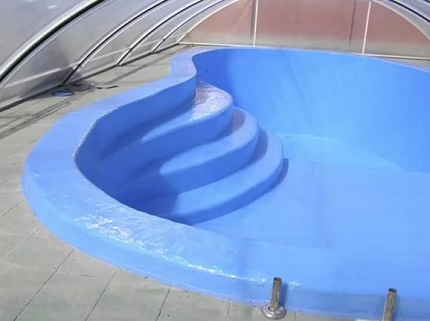
But not only concrete is threatened by excess moisture. Inside the walls of the bowl are usually reinforced with metal rods. The porous material freely passes water to the reinforcement.
As a result, it corrodes and crumbles quickly enough. Thus, without proper waterproofing, a bowl experiencing severe loads will literally crumble in the shortest possible time.
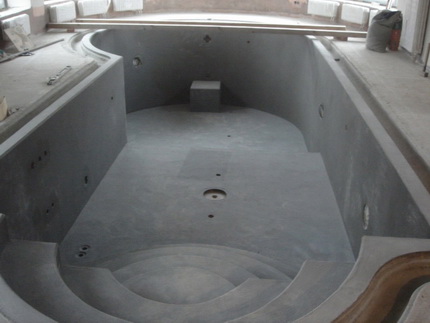
High-quality waterproofing of the pool must meet the following requirements:
- Durability and long service life;
- High resistance to adverse external influences;
- Good adhesion.
- High elasticity.
Ideally, the insulating layer should have all of the properties listed above and at the same time form a seamless monolithic coating that covers the entire surface of the bowl.
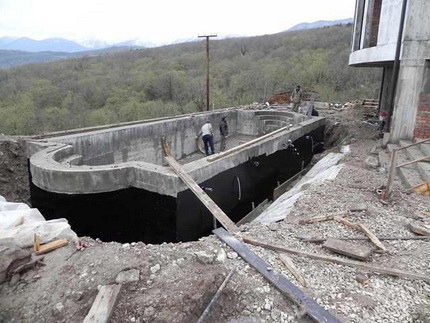
About methods waterproofing pool bowlsavailable to do it yourself is described in detail in this article. It also lists the materials necessary to form an impeccable defense.
Types of waterproofing pool
Protection of the structure from water is carried out from the external and internal sides, in connection with which the waterproofing materials used are divided into two groups.
External bowl moisture protection
External waterproofing is used to protect the structure from flood and groundwater. It is relevant for street structures deepened in the ground. Requirements for external waterproofing are similar to those presented to the moisture protection of foundations.
The main difference is the shrinkage indices and the changes in the geometry of the design of the bowl that occur under the influence of a significant mass of water on it. Before the construction of the bowl, it is necessary to carefully study the soil structure in the selected area, to find out the level of freezing of the soil, as well as the depth of the groundwater.
It is very important that the level of the bottom plate of the bowl is not lowered below the depth of the groundwater. If so, waterproofing alone will not be enough. In this case, groundwater must be diverted from the structure using a drainage system.
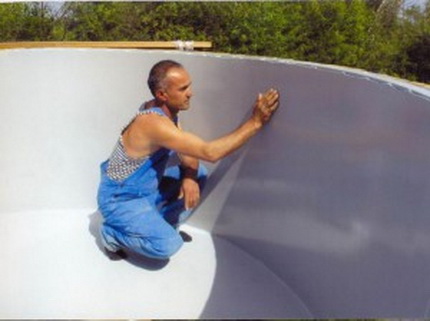
The most proven and affordable method of arranging external waterproofing is considered to be a clay castle, which is mounted directly during the construction period. After the soil is removed from the foundation pit prepared for the pool, clay is poured into it and carefully packed.
This is a clay castle. The best result can be achieved when it is used in combination with other insulating materials: gluing, coating or penetrating materials.
Choose the option of an external hydraulic barrier for the bowl at the design stage. After pool construction it is more expensive and more difficult to eliminate imperfections and apply material to the walls. And to protect the bottom will be generally impossible.
Internal waterproofing of the pool
Internal insulation of the bowl is mandatory for any type of pool. The insulating layer protects the material from which the structure is made from the damaging effects of moisture and chemical compounds.
Most often, the composition includes protection against disinfectants, which will necessarily be present in the water. The latter are relatively safe for humans, but for are an aggressive environment for building materials.
Waterproofing not only protects the pool from moisture, but also from possible leakage and corrosion. Internal insulation will be considered high-quality if it is resistant to opening holes and cracks up to 3 mm wide.
It is desirable that the waterproofing layer was low, but at the same time flexible. The material must have good adhesion to the base and maximum water resistance.
In addition, the insulation coating must resist hydrostatic and dynamic loads, fully comply with environmental standards. It would be good if the waterproofing suppressed the activity of microorganisms. Another important nuance is full compliance with the type of finish chosen, otherwise it will not be possible to conduct a full bowl lining.
Internal waterproofing of the bowl is applied at the final stages pool construction. It is possible to choose material for it even after completing all work on the construction of the bowl, but it is necessary before facing.
Materials for insulation work
A variety of materials can be used for waterproofing bowls. Each of them has certain advantages and disadvantages. To make an informed choice, you should carefully study the various types of isolation.
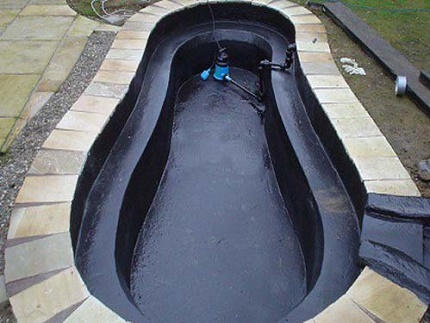
Bitumen Coatings
They appeared on the construction market more than half a century ago. Are issued in the form of the built-up rolled materials, roofing material, bituminous mastics.
Bituminous coatings have several advantages:
- High elasticity, which virtually eliminates damage to the insulation during operation and during further finishing work.
- Effective protection against moisture.
- Long term of operation.
- The ability to carry out work on laying material and subsequent finishing at any time of the year.
- Resistance to almost any aggressive effects, including chemicals.
- Most materials have an affordable cost.
Despite a fairly large number of advantages, bituminous coatings for waterproofing pools are rarely used. This is more true for surfaced roll materials, which are difficult to apply.
Hot solutions are also not easy to install. The main obstacle to the use of bitumen materials for pool insulation is poor adhesion with adhesives used for decorating bowls.

Cement based solutions
The composition of such mixtures usually includes three components. The first is astringent. It is a high-quality cement that provides strength to the material and partially repels water.
The second is a filler: fine quartz sand. The third is polymer additives. Various substances that increase the hydrophobic properties of the mixture, adhesion and elasticity. It can be synthetic resins or vinyl acetate.
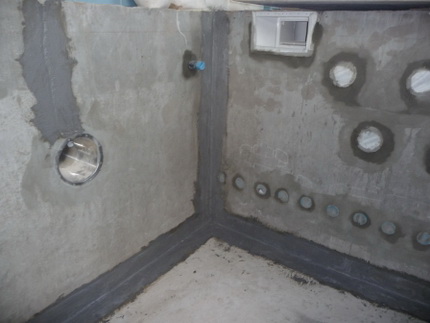
Cement-based waterproofing has many advantages:
- Good adhesion. The material holds well on wood, brick, concrete, metal, etc. The adhesion of cement insulation is much higher than that of bitumen-polymer or bitumen.
- High abrasion resistance and mechanical strength.
- Water permeability. The insulation does not allow water to penetrate into the base, but at the same time allows the moisture inside to evaporate. This ensures that no delamination is possible.
- Possibility of application, if necessary, not only on a dry, but also on a wet base.
- Environmental Safety.
- Quick drying. After 10-14 days, the surface treated with cement compositions is ready for further decoration. No additional preparation is required - finishing materials hold well on such a basis.
- Long service life.
Practice shows that throughout the entire period of operation, repair of cement waterproofing is not required. It is quite simple to apply and can be laid on the surface of a very different configuration.
The cost of coverage is relatively low. The main disadvantage of cement waterproofing is its high rigidity. It is not elastic, so if a crack appears in the bowl, the insulation layer will inevitably be destroyed.
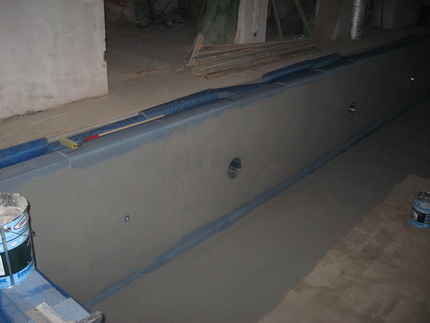
This problem is solvable. On sale you can find special two-component compositions based on cement with a high content of polymer component. Such mixtures are stacked in several layers. Between them, a reinforcing fiberglass mesh is mounted.
On all internal corners rubber-polymer elastic tapes are additionally superimposed. The result is an insulating coating that surpasses bitumen in its characteristics. However, its cost is quite high.
Penetrating type waterproofing
Penetration isolation is carried out in the form of a mixture, which includes high-quality Portland cement, filler and active chemical additives.
Additives are a salt of alkaline earth and alkali metals or polymers. After dissolving in water, a liquid working solution is obtained, which is superimposed on the base, forming an external protective coating.
Its main difference from analogues is that the composition penetrates into the base through pores, structural capillaries and microcracks. Here the mixture is converted into water-insoluble waterproofing crystals.
The base material becomes moisture resistant and at the same time hardens, which significantly extends its life. This effect does not give any of the known types of waterproofing.
In addition, coating and roll materials, when applied, form a non-breathing dense film on the surface. If there was moisture in the base pores, and this happens very often, it will remain inside, which over time can lead to mold.
Penetrating compounds work differently. When they enter the base pores, they crystallize and at the same time displace moisture and vapors to the outside.
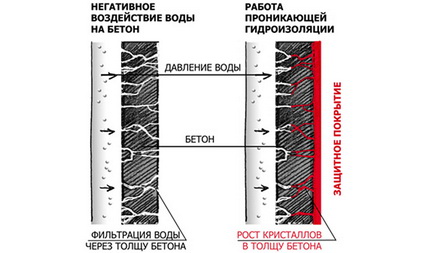
Only after all moisture has been removed from the base does the crystallization process stop and a protective layer forms on the surface. Penetrating mixtures can fill the thickness of the concrete base 35-40 cm in depth.
At the same time, penetrating compositions completely seal cracks and other defects up to 0.4 cm wide. The service life of the material is 70-100 years, while rolled and coated analogues last 25-30 years.
In addition to the advantages of penetrating waterproofing include the following:
- It forms a tight seamless coating that has high resistance to mechanical damage and aggressive chemical influences. It does not crack or peel.
- Easy preparation of the mixture and further installation. The composition may be applied to a moist base. There is no need for preliminary drying.
- Ability to handle both new and old designs. The latter is relevant during the repair work.
- Complete environmental safety for both people and the environment.
- When applied to a reinforced concrete structure, the composition protects the metal component from corrosion, which extends the service life by about three times.
- The composition can be applied in any weather. The temperature of application of the solution is from +75 to -30C. Formulations have been developed that can be used on hot surfaces.
- After the mixture dries, it becomes a good basis for further finishing. No preparatory work is required.
The disadvantages of penetrating materials include the selectivity of the application. They are not placed on very porous materials such as expanded clay concrete, slate concrete and the like.
A large number of pores will require a significant consumption of expensive insulation, which is very disadvantageous. In addition, the material should not be applied to the connection areas of the elements of water supply equipment with a concrete base.
Waterproofing film coating
It is a polyvinyl chloride or polyester film that fits into a bowl. Several varieties of this coating are produced. The least strength is unreinforced canvas.
This is a single-layer material with low operational characteristics and a budget price. Such a film is most often used to isolate prefabricated pool models.
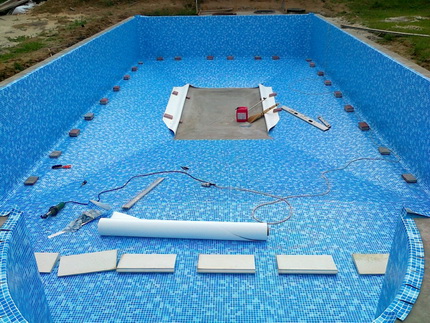
Reinforced films are characterized by greater reliability and durability.They are a multilayer coating, where reinforcing polyester threads are laid between the film panels.
Such a material can easily withstand sufficiently large loads without any signs of deformation. The outer coating of the films also varies. The most practical option is with an anti-slip layer.
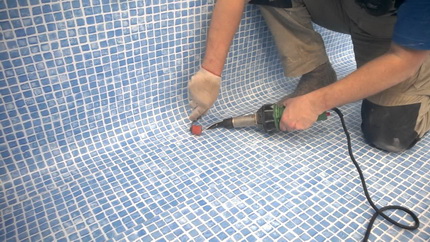
On sale you can find a film with an acrylic coating, which prevents the active reproduction of microorganisms, which greatly facilitates the care of the pool.
The advantages of a waterproofing film include:
- Attractive appearance. Such a coating is not only waterproofing, but also the decoration of the bowl. The material is available in a variety of colors and textures. Imitations of mosaic tiles, stone and sand are especially good.
- High resistance to various aggressive environments, frost resistance.
- Easy to care. The coating is easy to clean with the most common soapy solution.
- Possibility of laying during the construction process on a new bowl or during the repair on a prepared old foundation. In this case, the panel can be applied on top of the old finish, for example, laid on ceramic tile.
- Low cost of material.
Among the disadvantages, the main thing is the rather short service life of such a coating. It is about 5-10 years, after which the panel needs to be changed.
This is due to the fact that during operation the film inevitably loses its color saturation and becomes covered with scratches. This happens especially quickly with heavy use of the pool, for home installations the process usually proceeds more slowly.
Installation of a new coating is quite complicated and is most often performed by experienced craftsmen. During its implementation, special technologies are used. Including hot air welding of the joints of the panels. Even a small mistake can lead to water getting under the waterproofing carpet, which is unacceptable.
Liquid rubber for waterproofing
The coating is a modified latex-bitumen emulsion. It includes two mutually insoluble components - water and bitumen. At its core, it is a bitumen emulsion, the performance of which is improved with latex.
The name liquid rubber is somewhat unjustified, because the basis of the material is not rubber at all, like classical rubber. However, it has taken root. Two main varieties of coating are available: one and two-component.The latter has a more complex composition and better characteristics. In addition, the material differs in the method of application to the base.
It can be spraying, staining or pouring. I must admit that the best result gives the first option. True, its implementation requires special expensive equipment, which only trained workers can handle.
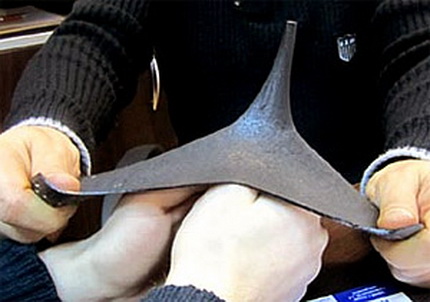
Liquid waterproofing has many advantages:
- It forms a monolithic completely sealed coating, on which there are no slightest joints.
- High adhesion to any base.
- Fills microcracks and small defects of the base.
- Good elasticity, which implies the ability to return to its original position after a short-term increase in size. Therefore, the coating is especially resistant to temperature extremes and high humidity.
- Short installation time. The process of applying liquid rubber is mechanized, which allows you to stack it several times faster than, for example, gluing materials.
- Environmental safety of waterproofing material.
- Good maintainability of the coating. Defects are easily eliminated by applying a new portion of the mixture.
- Liquid rubber may be coated with finishes. Perhaps use without additional decor. The material is available in various colors, which improves its decorative properties.
The disadvantages of liquid rubber include high sensitivity to ultraviolet radiation. You can not leave such a coating without applying a special protective layer if the pool is located in direct sunlight.
Another disadvantage is the rather high cost of the coating, especially if it is applied by spraying. In this case, the cost of applying it is added to the price of the material.
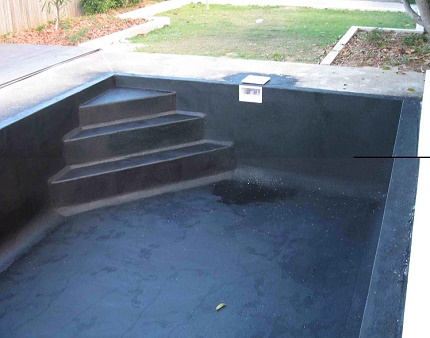
Liquid glass insulating coating
Under this name, a composition based on water in a mixture with natural potassium or sodium silicates is known. It is particularly viscous and copes with waterproofing.
Small crystals that are visible in the material, after application to the base, increase in size and fill with themselves all the cracks and small defects. Liquid glass is completely impervious to water and air.
In addition, the insulation coating also has antiseptic properties - microorganisms do not live on it. It is antistatic, that is, it does not accumulate static electricity. Liquid glass acts as a hardener for the base. It significantly strengthens the structure of the material on which it is applied.
In addition, the advantages of liquid waterproofing include:
- High degree of adhesion. The material fits perfectly on almost any base, penetrating into the smallest cracks and thereby cementing them.
- The resulting insulation coating has no seams and joints, is completely tight.
- High water repellent ability. The insulation layer is completely impervious to water.
- Relatively small compared to other waterproofing materials, the cost of the finished coating.
- Economical consumption of liquid glass when laying the insulating layer.
- Environmental Safety. The waterproofing agent does not include toxic substances.
- The ability to lay the coating in high humidity, which is impossible for other materials.
Disadvantages of liquid glass are enough. First of all, it is a short service life. He is only 5 years old. After this time, the material begins to self-destruct.
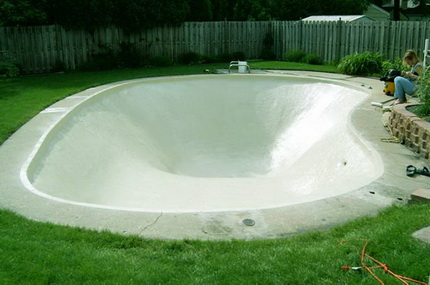
True, if it is covered with a protective layer of paint, it will last much longer. On brick surfaces, liquid glass is not recommended, otherwise the base may be destroyed. Another disadvantage is the difficulty in applying the material, since it dries very quickly.
Conclusions and useful video on the topic
Video # 1. How to use liquid rubber for waterproofing the pool:
Video # 2. Waterproofing of the pool with polyvinyl chloride roll material:
Video # 3. Features of the use of liquid glass:
We made sure that the range of waterproofing materials that can be used in the construction of swimming pools is quite large.
When choosing the best option, you should consider the material from which the bowl will be made, the operating conditions of the structure and other features of a particular design. Only in this case can it be expected that the new pool will serve for a long time and without problems.
Please comment on the material proposed for consideration in the block located below the text of the article. We are interested in your opinion, stories about the experience of building a private pool and a suburban area. We are waiting for useful tips, suggestions and photographs on the topic.

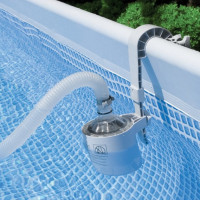 How to choose a pump for the pool: a comparative overview of different types of units
How to choose a pump for the pool: a comparative overview of different types of units 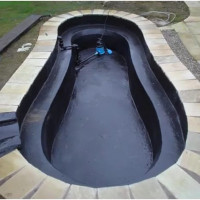 Do-it-yourself pool waterproofing: technology overview + step-by-step example of work
Do-it-yourself pool waterproofing: technology overview + step-by-step example of work 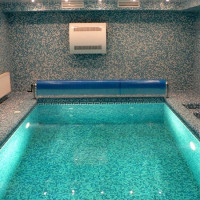 Dehumidifiers for pools: how to choose and calculate the optimal dehumidifier
Dehumidifiers for pools: how to choose and calculate the optimal dehumidifier  How to make a pool with your own hands: step-by-step instructions for the construction
How to make a pool with your own hands: step-by-step instructions for the construction 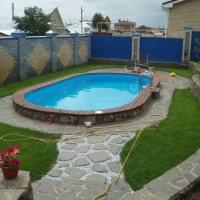 How to make a pool in the country with your own hands: the best options and master classes
How to make a pool in the country with your own hands: the best options and master classes 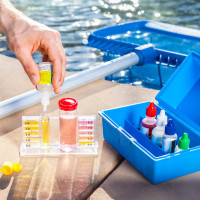 Coagulants for water purification in the pool: how to choose + application rules
Coagulants for water purification in the pool: how to choose + application rules  How much does it cost to connect gas to a private house: the price of organizing gas supply
How much does it cost to connect gas to a private house: the price of organizing gas supply  The best washing machines with dryer: model rating and customer tips
The best washing machines with dryer: model rating and customer tips  What is the color temperature of light and the nuances of choosing the temperature of the lamps to suit your needs
What is the color temperature of light and the nuances of choosing the temperature of the lamps to suit your needs  Replacement of a geyser in an apartment: replacement paperwork + basic norms and requirements
Replacement of a geyser in an apartment: replacement paperwork + basic norms and requirements
We used a special mastic from a German manufacturer for waterproofing. It is very expensive, really. It is applied with a brush as a paint, in several layers (2-3 layers) with small technological gaps required for drying and polymerization. This mastic is used for waterproofing underground and underwater tunnels, so it is designed for high water pressure. Any final finish can be made from above.
I used liquid rubber as a waterproofing for my pool in the country, it penetrates well into all cracks, even the smallest. Used gray color.
From the first time I didn’t quite manage to evenly distribute it around the entire perimeter of the pool, so I had to additionally go through the “unfinished” places.
Then put the decor on top of it.
The pool already serves us the third season. There are no complaints so far.